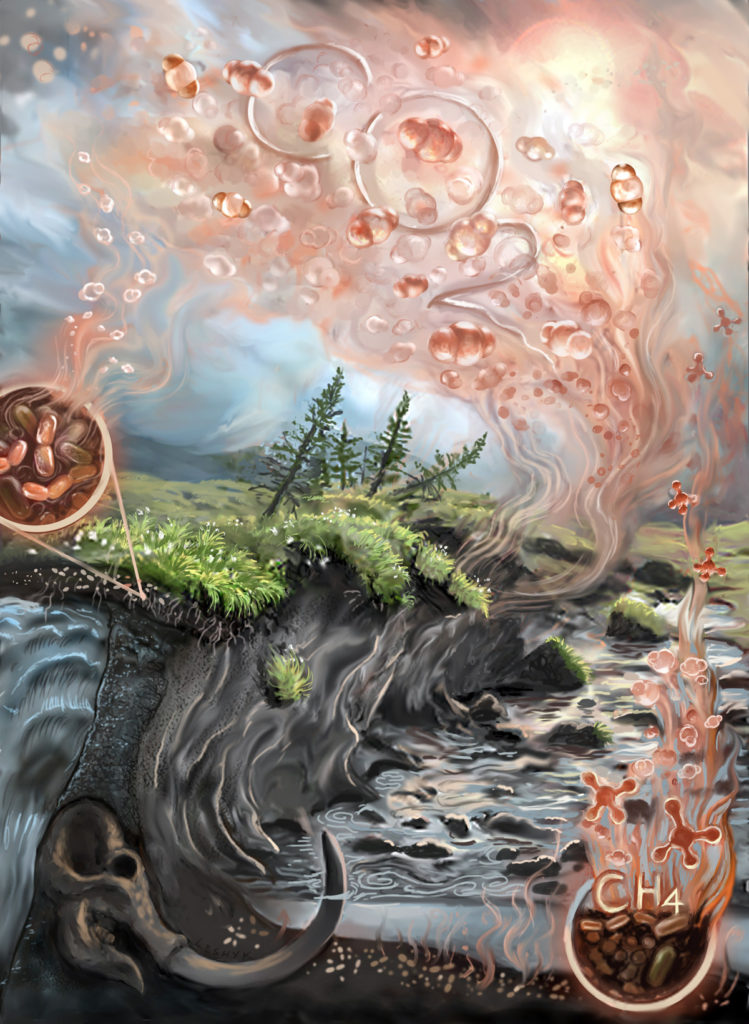When it comes to climate change, not all carbon is created equal. Among greenhouse gases, methane is 34 times more potent than carbon dioxide.
In the Arctic, where temperatures are rising twice as fast as anywhere else in the world, scientists want to understand the ratio of carbon dioxide to methane gas released by thawing permafrost—the frozen ground in that region. As the permafrost thaws, microbes wake up and begin digesting the newly available remains of ancient plants and animals stored as carbon in the soil. This digestion produces either carbon dioxide or methane, depending on soil conditions. The ratio of those two gases affects the strength of the permafrost carbon feedback loop: greenhouse gases released due to thawing permafrost cause temperatures to rise, leading to even more thawing and carbon release.
Because the Arctic permafrost is like a vast underground storage tank of carbon, holding almost twice as much as the atmosphere, small changes in how the carbon is released will have big effects.

Northern Arizona University assistant research professor and lead author of the study, Christina Schädel, analyzed carbon release from 25 Arctic soil incubation studies to learn more about the conditions promoting either carbon dioxide or methane release. Schädel and NAU professor of ecosystem ecology Ted Schuur lead the Permafrost Carbon Network, an international group of scientists studying the release of carbon from permafrost as temperatures warm. Many members of the Permafrost Carbon Network contributed data to this study, published in Nature Climate Change.
Schädel zeroed in on two factors: soil temperature and the availability of oxygen. Soils in the lab were incubated at a range of warmer temperatures projected for the future. The availability of oxygen is important because it determines how microbes digest carbon. Oxygen-rich, or aerobic, conditions are found in dry soils and produce carbon dioxide. Oxygen-poor, or anaerobic, conditions are found in wet soils and produce both carbon dioxide and methane. Lab incubations mimicked these two conditions.
Schädel’s analysis showed that a 10 °C increase in soil temperature released twice as much carbon into the atmosphere. It also showed that drier, aerobic soil conditions released more than three times more carbon than wetter, anaerobic soil conditions. Most of that carbon was in the form of carbon dioxide, mixed with a surprisingly small amount of methane—only 5% of the total anaerobic products. This means that even though methane packs a bigger climate warming punch, the small quantity released relative to carbon dioxide in anaerobic conditions makes wet soils less of a concern than dry soils.
“Our results show that increasing temperatures have a large effect on carbon release from permafrost but that changes in soil moisture conditions have an even greater effect,” says Schädel. “We conclude that the permafrost carbon feedback will be stronger when a larger percentage of the permafrost zone undergoes thaw in a dry and oxygen-rich environment. “
Will wet or dry soils dominate the future Arctic permafrost zone? The answer to this question is a big unknown. Schädel’s work, however, will strengthen existing models of the permafrost ecosystem. Her work also highlights the need to monitor changes in wetness associated with permafrost thaw, changes that ultimately sculpt the topography of waterlogged depressions and dry uplands across the Arctic landscape.
The study received primary funding from the National Science Foundation with additional support from the U.S. Department of Energy.



